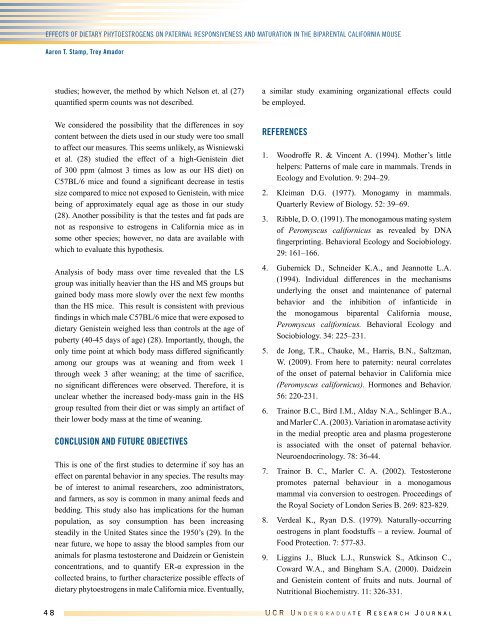Undergraduate Research Journal
Undergraduate Research Journal
Undergraduate Research Journal
You also want an ePaper? Increase the reach of your titles
YUMPU automatically turns print PDFs into web optimized ePapers that Google loves.
Effects of Dietary Phytoestrogens on Paternal Responsiveness and Maturation in the Biparental California Mouse<br />
Aaron T. Stamp, Trey Amador<br />
studies; however, the method by which Nelson et. al (27)<br />
quantified sperm counts was not described.<br />
We considered the possibility that the differences in soy<br />
content between the diets used in our study were too small<br />
to affect our measures. This seems unlikely, as Wisniewski<br />
et al. (28) studied the effect of a high-Genistein diet<br />
of 300 ppm (almost 3 times as low as our HS diet) on<br />
C57BL/6 mice and found a significant decrease in testis<br />
size compared to mice not exposed to Genistein, with mice<br />
being of approximately equal age as those in our study<br />
(28). Another possibility is that the testes and fat pads are<br />
not as responsive to estrogens in California mice as in<br />
some other species; however, no data are available with<br />
which to evaluate this hypothesis.<br />
Analysis of body mass over time revealed that the LS<br />
group was initially heavier than the HS and MS groups but<br />
gained body mass more slowly over the next few months<br />
than the HS mice. This result is consistent with previous<br />
findings in which male C57BL/6 mice that were exposed to<br />
dietary Genistein weighed less than controls at the age of<br />
puberty (40-45 days of age) (28). Importantly, though, the<br />
only time point at which body mass differed significantly<br />
among our groups was at weaning and from week 1<br />
through week 3 after weaning; at the time of sacrifice,<br />
no significant differences were observed. Therefore, it is<br />
unclear whether the increased body-mass gain in the HS<br />
group resulted from their diet or was simply an artifact of<br />
their lower body mass at the time of weaning.<br />
CONCLUSION AND FUTURE OBJECTIVES<br />
This is one of the first studies to determine if soy has an<br />
effect on parental behavior in any species. The results may<br />
be of interest to animal researchers, zoo administrators,<br />
and farmers, as soy is common in many animal feeds and<br />
bedding. This study also has implications for the human<br />
population, as soy consumption has been increasing<br />
steadily in the United States since the 1950’s (29). In the<br />
near future, we hope to assay the blood samples from our<br />
animals for plasma testosterone and Daidzein or Genistein<br />
concentrations, and to quantify ER-α expression in the<br />
collected brains, to further characterize possible effects of<br />
dietary phytoestrogens in male California mice. Eventually,<br />
a similar study examining organizational effects could<br />
be employed.<br />
References<br />
1. Woodroffe R. & Vincent A. (1994). Mother’s little<br />
helpers: Patterns of male care in mammals. Trends in<br />
Ecology and Evolution. 9: 294–29.<br />
2. Kleiman D.G. (1977). Monogamy in mammals.<br />
Quarterly Review of Biology. 52: 39–69.<br />
3. Ribble, D. O. (1991). The monogamous mating system<br />
of Peromyscus californicus as revealed by DNA<br />
fingerprinting. Behavioral Ecology and Sociobiology.<br />
29: 161–166.<br />
4. Gubernick D., Schneider K.A., and Jeannotte L.A.<br />
(1994). Individual differences in the mechanisms<br />
underlying the onset and maintenance of paternal<br />
behavior and the inhibition of infanticide in<br />
the monogamous biparental California mouse,<br />
Peromyscus californicus. Behavioral Ecology and<br />
Sociobiology. 34: 225–231.<br />
5. de Jong, T.R., Chauke, M., Harris, B.N., Saltzman,<br />
W. (2009). From here to paternity: neural correlates<br />
of the onset of paternal behavior in California mice<br />
(Peromyscus californicus). Hormones and Behavior.<br />
56: 220-231.<br />
6. Trainor B.C., Bird I.M., Alday N.A., Schlinger B.A.,<br />
and Marler C.A. (2003). Variation in aromatase activity<br />
in the medial preoptic area and plasma progesterone<br />
is associated with the onset of paternal behavior.<br />
Neuroendocrinology. 78: 36-44.<br />
7. Trainor B. C., Marler C. A. (2002). Testosterone<br />
promotes paternal behaviour in a monogamous<br />
mammal via conversion to oestrogen. Proceedings of<br />
the Royal Society of London Series B. 269: 823-829.<br />
8. Verdeal K., Ryan D.S. (1979). Naturally-occurring<br />
oestrogens in plant foodstuffs – a review. <strong>Journal</strong> of<br />
Food Protection. 7: 577-83.<br />
9. Liggins J., Bluck L.J., Runswick S., Atkinson C.,<br />
Coward W.A., and Bingham S.A. (2000). Daidzein<br />
and Genistein content of fruits and nuts. <strong>Journal</strong> of<br />
Nutritional Biochemistry. 11: 326-331.<br />
4 8 U C R U n d e r g r a d u a t e R e s e a r c h J o u r n a l














